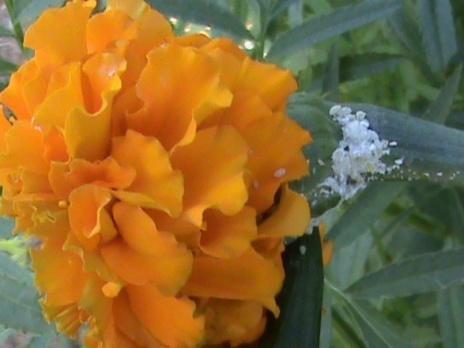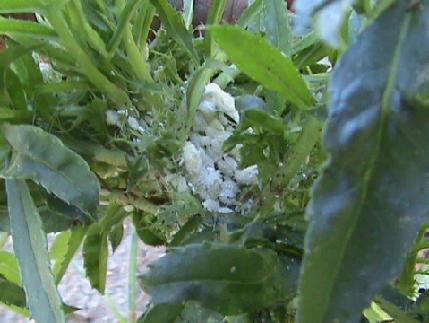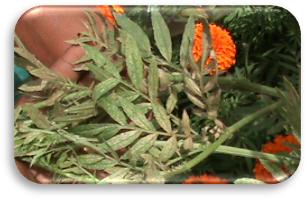AFRICAN MARIGOLD (Tagetes erecta L.)
Asteraceae
Varieties
Local types (orange & yellow), Pusa Narangi Gainda, Pusa Basanthi Gainda (IARI varieties) and MDU 1 can be cultivated.
Soil
Well drained loamy soil is found suitable. The soil pH should be 7.0 to 7.5. Saline and acidic soils are not suitable for cultivation.
Seeds and sowing
The seeds are sown throughout the year. Nursery is raised with 1.5 kg seeds/ha and the seedlings are transplanted after four weeks on one side of the ridge at 45 x 35 cm spacing. Treat the seeds with Azospirillum (200 g in 50 ml of rice gruel) before sowing.
Irrigation
Irrigation is done once in a week or as and when necessary. Water stagnation should be avoided.
Manuring
During last ploughing, incorporate 25t/ha of FYM. Apply 45:90:75 kg NPK/ha as basal and 45 kg N/ha as top dressing 45 days after planting.
After cultivation
Weeding should be done as and when necessary. Irrigation should be given immediately after planting and life irrigation on third day after planting. Water stagnation should be avoided. Based on the soil moisture condition, irrigation should be done.
Nipping/tipping
Thirty days after planting terminal portion should be tipped / removed to encourage the branching.
Plant protection
Pests:
Mealy bug:
Damage symptom:
Mealy bugs are crowdly present in young shoots, stem and leaves. Flattening and crinkled with dark green leaves. It’s segregate honey like substances because of that leaves are converted into black sooty mould. Apical parts of the shoots show retarted growth.
 |
 |
Mealy bug infestation in flower and shoots |
Control measures
- Spray prophenophos or dimethoate @ 2ml/litre.
- Spray Fish oil rosin soap @ 25g/litre
Thrips - Thrips tabaci:
 |
Damage symptom
Discoloured or distorted plant tissue is clues that thrips were present. Thrips prefer to feed in rapidly growing tissue. Damaged leaves become papery and distorted. Infested terminals may discolour, rolled and drop leaves prematurely.
Petals may exhibit “colour break,” which is pale tissue that was killed by thrips feeding before buds opened.
Control measures
- Set up yellow sticky trap 20 per acre
- Released Amphelicies cucumeris spider parasitoid.
- Fipronil 1.5ml/litre or spiromesifen 0.75ml/litre or azardiractin 3ml/litre
|
Spider
It can be controlled by spraying Kelthane 1 ml/lit of water
Leaf spot
Leaf spot can be controlled by spraying Bavistin 1 g / lit of water
Root rot
Drench 1 g/lit of Bavisitin to control root rot.
Crop duration
The crop duration is about 130 - 150 days.
Harvest
Flowers are picked once in 3 days beginning from 60 days after planting.
Yield
The average yield is about 18 t/ha.
Precision production technology
Hybrid: L3 hybrid (cultivated for xanthophyll extraction).
Seeds and sowing: Sown throughout the year. Seed rate is 100 g/acre. Seeds are sown in protrays and 20 day old seedlings are transplanted on raised beds at 90 x 22.5 cm spacing to accommodate 44,400 plants/ha. Treat the seedlings with Pseudomonas fluorescens @ 0.5% before planting.
Fertigation: Recommended Dose of Fertilizer (RDF) is 90: 90:75kg NPK/ha. 75% RDF is applied through fertigation [Water Soluble Fertilizer (WSF) application through drip irrigation]. Water Soluble Fertilizers such as Polyfeed (19:19:19), Potassium Nitrate (13:0:45) and Urea (46% N) can be used.
Biofertilizers: Soil application of2 kg each of Azospirillum and Phosphobacteria per ha at the time of planting. Biofertilizers are to be mixed with 100kg of FYM and applied.
Micronutrients: Foliar spray of FeSO4 0.5% + ZnSO4 0.5% on 30th and 45th day after transplanting.
Biostimulants: SprayHumic acid @ 0.2% on 30 & 45 days after transplanting.
Plant protection
Pests:
Cut worms and Helicoverpa armigera
Spray spinosad 45 SC @ 0.75ml/litre. Spinosad 45 SC is quickly biodegradable and is accepted by the importers
Mealy bug: Spray Prophenophos @ 2ml/l Fish oil rosin soap @ 25 g/l
Bud borer: Spray Spinosad @ 0.75 ml / l
Leaf miner / thrips: Spray Fipronil @ 1.5ml/l
Red spider Mite: Spray Abamectin 1.9 EC @ 0.5 ml/l or Fenazaquin @ 2 ml/l or Exodus (natural lactones) @ 2 ml/l
Diseases:
Leaf spot : Foliar application of Hexaconazole @1ml/litreor Mancozeb @ 2g/litre
Yield:Flowers : 30 - 35 t/ha.
Xanthophyll : 1.7 - 1.9 g/kg of fresh flowers.
Source
1. http://pics.davesgarden.com/pics/Xenomorf_1086206604_689.jpg
2. http://farm1.static.flickr.com/122/292149274_2ce31bc16f.jpg
|



